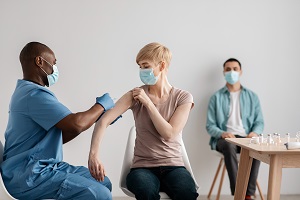Firstly, needle sticks and other sharps injuries are highly dangerous in the healthcare setting. secondly, the risk of needle stick injury is higher for healthcare workers who use or may be exposed to needles. Bloodborne pathogens such as hepatitis B, C, and the human immunodeficiency virus can cause serious or fatal infections as a result of such injuries (HIV). Therefore, for preventing needle stick and sharps injuries healthcare workers should avoid using needles whenever safe and effective alternatives are available.
Needle stick injuries can be avoided by not using needles unless necessary, using devices with safety features, and promoting needle handling education.
Therefore, the Preventing Needle Sticks and Sharps Injuries course is designed to educate healthcare providers (HCP) about the needle sticks procedure, and the prevention act.
What you’ll learn
- Needle-stick procedure
- How employees can prevent a needle-stick
- Needle-stick Safety and Prevention Act
- PPEs and engineering controls
- Summary of additional protection
Details
Course length: 30 minutes; CEU: 0.5.
Languages: American English
Key features: Audio narration, learning activity, and post-assessment
Get Certified
American Medical Compliance (AMC) is a leader in the industry for compliance, Billing, and HR solutions. To become certified, please visit us at American Medical Compliance (AMC).
Explore our other courses by visiting the AMC Course Library.
OSHA-Recommended Needle-Stick Procedure
There have been estimates that nearly 6 million workers in the healthcare industry and related fields are at risk of exposure to bloodborne pathogens. Bloodborne pathogens are pathogenic microorganisms that are present in the human bloodstream. These pathogens have the ability to cause diseases in humans. Therefore, there are certain requirements from OSHA for recording work-related needle-stick injuries and cuts and handling infectious material such as blood. Our course describes all of the criteria that OSHA requires from each needle-stick injury. There are also regulations regarding cuts or lacerations that did not involve infectious material such as blood, which this training also outlines. It is crucial to follow proper needle-stick procedures and protocol to keep bloodborne pathogen infection rates down. There are certain steps one must follow immediately after a needle-stick to limit possible infection. Proper wound care is crucial for stopping the spread of infection.
Needle-Stick Safety and Prevention Act
Occupational exposure to bloodborne pathogens has continued to be a serious problem. With the purpose of revitalizing OSHA’s Bloodborne Pathogen Standard the Needlestick Safety and Prevention Act was signed into law in 200. This act created additional requirements for emergency medical workers to evaluate and implement safer medical devices.
This act created new OSHA regulations. For example, OSHA requires that employers implement new procedures when updating their exposure control plan.
Additionally, all sharp instruments must be reviewed and evaluated annually. This course elaborates on the required elements of the annual sharps review and other OSHA regulations.
Information on Blood-work
It is important to report these incidents immediately because they can lead to infection with Hepatitis B, Hepatitis, C, HIV, and other bloodborne pathogens. Here are some steps to follow after a needle-stick incident has occurred:
Notify your supervisor. Then, arrange for an immediate medical evaluation of the worker involved in the incident. You also must determine who the source individual is. If the status of such an individual is not already known, employers must test the source’s blood as soon as possible.
Conduct blood-work IMMEDIATELY once a work-related needle-stick injury or cut has occurred. This is to determine the potential levels of exposure to bloodborne pathogens.
It is important to remember that the results of employee blood-work are medical records, and are therefore confidential. Employees may go to their primary care physicians or an Urgent Care or Hospital for consultation. This course provides several recommendations on employee consultations to ensure proper treatment. This training also gives tips on how needle-stick incidents can be prevents. An example of this is avoiding recapping needles.
Benefits of an Online Preventing Needlesticks and Sharps Injuries Course
Online courses offer numerous benefits that make them a popular choice for learning in today’s digital age. Firstly, flexibility is a key advantage. This is because online courses allow learners to access course materials and participate in lessons at their own pace and on their own schedule. Additionally, online courses provide a wide range of subjects and disciplines. This gives learners the opportunity to acquire new skills from the comfort of their own homes. Lastly, the affordability of online courses compared to traditional in-person education is a significant advantage. Online courses make quality education more accessible and affordable for many individuals. With the ability to access course materials anytime, anywhere, online courses offer a flexible, diverse, interactive, and cost-effective approach to continuing education.



